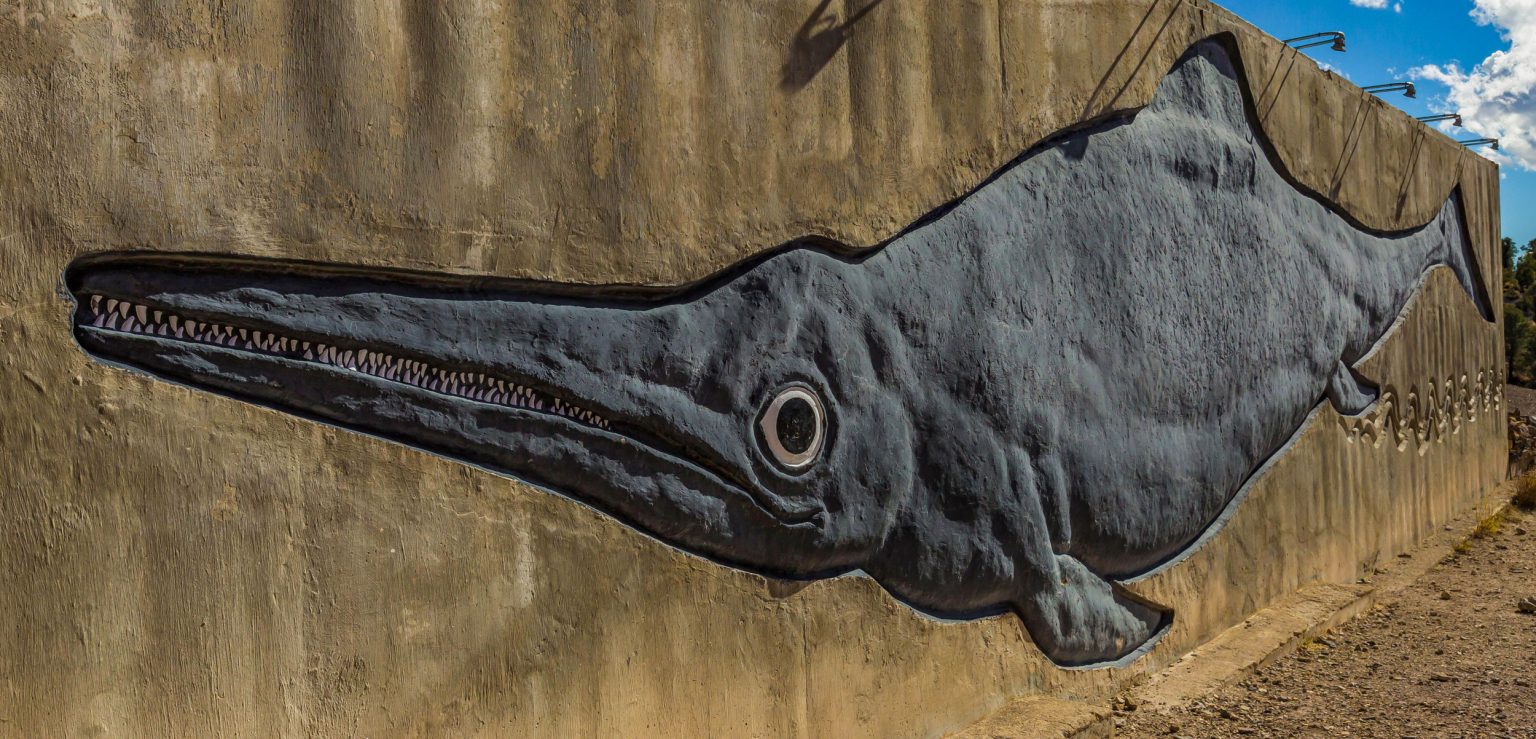
Paleontologists once believed Shonisaurus popularis, a kind of ichthyosaur, was a toothless giant. New fossil evidence is challenging that notion. Photo by Lee Rentz/Alamy Stock Photo
Shonisaurus Gets a MakeoverA new understanding of an ancient leviathan is developing in the middle of a Nevada desert.In the middle of nowhere Nevada, the desert rises up from the wreck of an ancient seafloor. Shards of coil-shelled ammonites peek out from clusters of Utah juniper. And in a great fossiliferous heap, the bones of giant sea creatures prompt the question of how so many whale-sized reptiles came to be buried here over 200 million years ago.
In 1863, prospectors searching the parched center of the Sagebrush State found silver. The town of Berlin, Nevada, boomed and busted in the chase for the precious metal, becoming a collection of rickety shanties and ominous mine shafts. But there was something else the miners found: enormous bones that couldn’t possibly have come from any animal prowling the desert.
Those bones belonged to
Shonisaurus popularis, a kind of ichthyosaur, or “fish lizard,” that reached 15 meters in length—the size of a humpback whale. And in the hills of what became Berlin-Ichthyosaur State Historic Park, there was a whole mess of them.
As many as 40
Shonisaurus individuals were uncovered in the 1950s by University of California, Berkeley, paleontologist Charles Camp—so many that he constructed a cabin on-site to explore, excavate, and catalog the fossils. Most were sent back to Berkeley for study, but skeletons in the largest quarry were covered and left in place.
Exactly what happened at this place 217 million years ago has confounded researchers. Experts have proposed everything from a choking algal bloom to a hyperintelligent cephalopod that decorated its den with ichthyosaur bones—a tall tale based on supposed patterns in the way the bones lay.
Scientists are still plying the largest quarry for answers as to what caused at least 10
Shonisaurus to perish at the same time, piled on top of each other like sleeping puppies.
Neil Kelley, a paleontologist at Tennessee’s Vanderbilt University, first heard of the site when he got one of the park’s signature T-shirts as a gift.
“I had the mistaken impression that all of the work at Berlin-Ichthyosaur was done,” Kelley says. It was only after he partnered with Smithsonian Institution paleontologist Nick Pyenson—who was using laser-scanning technology to understand how massive bone beds of whales had formed—that Kelley started to think about Camp’s site.
Additional experts have joined the search, including paleontology graduate student Paige dePolo from the University of Edinburgh in Scotland.
“Berlin-Ichthyosaur State Park feels like home to me,” says dePolo, who began her paleontological career at the site.
Already, Kelley and dePolo’s retread of Camp’s steps has led scientists to reimagine the ichthyosaur’s place in Triassic seas.
Shonisaurus, despite some popular depictions that cast it with a toothless, friendly grin, was not an animal you’d want to jump in the water with.
The largest extant marine animals are filter-feeders. That made it easy to think that
Shonisaurus didn’t have any teeth.
“The large size [was] part of the misconception,” Kelley says. But reexaminations of the bone heap have altered that image.
“Shonisaurus has large, pointed teeth that are deeply rooted,” says dePolo.
Researchers now suspect that the ichthyosaur was an enormous predator—more akin to a whale-sized crocodile than a baleen whale. Kelley hypothesizes that
Shonisaurus was an opportunistic predator, crunching the shells of ammonites and feeding on other marine reptiles.
The carnivorous habits of
Shonisaurus fit with what researchers have slowly been learning about the Triassic. This was the first period in Earth’s history when truly huge seagoing vertebrates preyed on others. Big meat-eating ichthyosaurs were common, and
Shonisaurus was among the largest of all.
Being an opportunist apparently served
Shonisaurus well. Kelley says the ichthyosaurs have been found from Alaska to Mexico in remnants of tropical seas that often hosted coral reefs. But they are never found in such numbers as at Berlin-Ichthyosaur State Historic Park. There,
Shonisaurus outnumbers all other fossilized vertebrates.
The abundance of
Shonisaurus in and around central Nevada might mean this place was special to the reptiles, says Kelley. Perhaps it was a place to mate, give birth, or migrate across. Thinking back to the oceans of the Triassic, Kelley says,
“I like to imagine flying low and … seeing hundreds of thousands of giant ichthyosaurs moving through.”LINK: www.hakaimagazine.com/news/shonisaurus-gets-a-makeover/